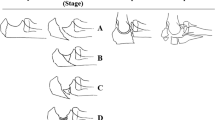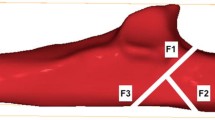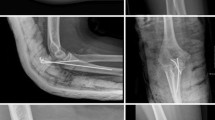Abstract
Introduction
Fractures of the olecranon are among the most common injuries involving the upper extremity and require operative intervention if displaced. The most commonly used method of fixation for this type of fracture is the AO tension band wiring, although the results of this technique have been generally good, still problems have occurred, including loss of fixation, nonunion, and high re-operation rate for hardware removal.
Aim of the study
To compare the results of treatment of displaced fractures of the olecranon using AO tension band wiring versus intramedullary screw with tension band.
Materials and methods
In a prospective study, 30 patients with transverse or oblique olecranon fractures, were randomly divided into two equal groups, one group treated using AO tension band wiring the other group using an intramedullary cancellous screw plus tension band.
Results
In the screw plus tension band group, 11 (73.3%) patients had excellent results, four (26.7%) had good results and none had fair or poor results, only one(6.6%) patient required second operation for removal of prominent hardware. In the AO tension band group, six (40%) patients had excellent results, five (33.3%) had good, three (20%) had fair and one (6.7%) patient had poor result, and eight patients (53.3%) required second operation for removal of prominent hardware.
Conclusion
Using an intramedullary screw combined with tension band in treatment of displaced transverse and oblique olecranon fractures gives better clinical results and has much less re-operation rate for removal of hardware when compared to AO tension band wire fixation, avoiding costs, work time loss and possible complications from hardware removal.


Similar content being viewed by others
References
Hak DJ, Golladay GJ (2000) Olecranon fractures: treatment options. J Am Acad Orthop Surg 8:266–275
Papagelopoulos PJ, Morrey BF (1994) Treatment of nonunion of olecranon fractures. J Bone Joint Surg 76-B:627–635
Amis AA, Miller JH (1995) The mechanisms of elbow fractures: an investigation using impact tests in vitro. Injury 26:163–168
Fyfe IS, Mossad MM, Holdsworth BJ (1985) Methods of fixation of olecranon fractures. An experimental mechanical study. J Bone Joint Surg 67-B:367–372
Murphy DF et al (1987) Displaced olecranon fractures in adults. Biomechanical analysis of fixation methods. Clin Orthop Relat Res 224:210–214
Horner SR et al (1989) Analysis of mechanical factors affecting fixation of olecranon fractures. Orthopedics 12:1469–1472
Rowland SA, Burkhart SS (1992) Tension band wiring of olecranon fractures. A modification of the AO technique. Clin Orthop Relat Res 277:238–242
Heim U, Pfeiffer K (1974) Small fragment set manual: technique recommended by the ASIF-Group. Springer, New York, p 743
Murphy DF, Greene WB, Dameron TB (1987) Displaced olecranon fractures in adults. Clinical evaluation. Clin Orthop Relat Res 224:215–223
Hutchinson DT et al (2003) Cyclic loading of olecranon fracture fixation constructs. J Bone Joint Surg 85-A:831–837
Wolfgang G et al (1987) Surgical treatment of displaced olecranon fractures by tension band wiring technique. Clin Orthop Relat Res 224:192–204
Inglis AE, Pellicci PM (1980) Total elbow replacement. J Bone Joint Surg 62-A:1252–1258
Gartsman GM, Sculco TP, Otis JC (1981) Operative treatment of olecranon fractures. Excision or open reduction with internal fixation. J Bone Joint Surg 63-A:718–721
Eriksson E, Sahlin O, Sandahl U (1957) Late results of conservative and surgical treatment of fracture of the olecranon. Acta Chir Scand 2:153–166
Horne JG, Tanzer TL (1981) Olecranon fractures: a review of 100 cases. J Trauma 21:469–472
Kiviluoto O, Santavirta S (1978) Fractures of the olecranon. Analysis of 37 consecutive cases. Acta Orthop Scand 1:28–31
Rettig AC, Waugh TR, Evanski PM (1979) Fracture of the olecranon: a problem of management. J Trauma 19:23–28
Chapman MW, Mahoney M (1979) The role of early internal fixation in the management of open fractures. Clin Orthop Relat Res 138:120–131
Romero JM, Miran A, Jensen CH (2000) Complications and re-operation rate after tension-band wiring of olecranon fractures. J Orthop Sci 5:318–320
Macko D, Szabo RM (1985) Complications of tension-band wiring of olecranon fractures. J Bone Joint Surg 67A:1396–1401
Deliyannis SN (1973) Comminuted fractures of the olecranon treated by the Weber-Vasey technique. Injury 5:19–24
Müller M et al (1991) Manual of internal fixation: techniques recommended by the AO-ASIF group, 3rd edn. Springer, Berlin
Scharplatz D, Allgower M (1975) Fracture-dislocations of the elbow. Injury 7:143–159
Colton CL (1973) Fractures of the olecranon in adults: classification and management. Injury 5:121–129
Morrey BF (1995) Current concepts in the treatment of fractures of the radial head, the olecranon, and the coronoid. Instr Course Lect 44:175–185
Conflict of interest statement
No funds were received in support of this study
Author information
Authors and Affiliations
Corresponding author
Rights and permissions
About this article
Cite this article
Ahmed, A.R., Sweed, T. & Wanas, A. The role of cancellous screw with tension band fixation in the treatment of displaced olecranon fractures, a comparative study. Eur J Orthop Surg Traumatol 18, 571–576 (2008). https://doi.org/10.1007/s00590-008-0355-0
Received:
Accepted:
Published:
Issue Date:
DOI: https://doi.org/10.1007/s00590-008-0355-0




